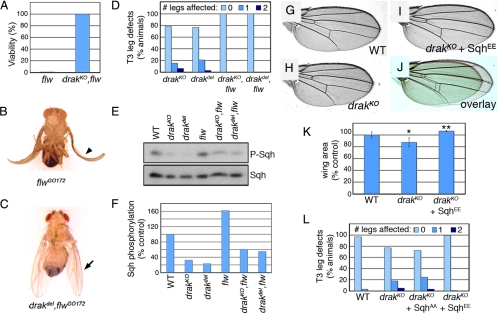Figure 6.
Increasing Sqh activity rescues drak mutant phenotypes. (A) Plot of the viability of flwGO172/Y (expected n + 137) and drakKO,flwGO172/Y (n + 79) flies. (B) flwGO172/Y fly, showing abnormal curled wing phenotype of rare flw adult escapers (arrowhead). (C) drakdel,flwGO172/Y fly, with normal wing morphology (arrow). (D) Quantification of leg defects in drakKO/Y (n + 77), drakdel/Y (n + 98), drakKO,flwGO172/Y (n + 66), and drakdel,flwGO172/Y (n + 135) flies. (E and F) Western blot analysis of third instar wing imaginal disc lysates prepared from wild-type, drakKO/Y, drakdel/Y, flwGO172/Y, drakKO,flwGO172/Y, and drakdel,flwGO172/Y larvae, using anti-phospho-MRLC and anti-Sqh antibodies. Levels of phospho-Sqh, normalized to total Sqh levels, are plotted in F. (G–I) Wings from wild-type (G), drakKO/Y (H), and drakKO/Y;SqhEE/+ (I) flies. Wings closest to the mean measured wing areas for each genotype were chosen. (J) Overlay of wings in H and I, false colored green and red, respectively. (K) Measurements of wing areas (average ± SD). n + 12 for each genotype. *, significantly different from wild-type (p < .001). **, significantly different from drakKO/Y (p < 0.001). (L) Quantification of leg defects in wild-type (n + 96), drakKO/Y (n + 223), drakKO/Y;SqhAA/+ (n + 98), and drakKO/Y;SqhEE/+ (n + 215) flies.

